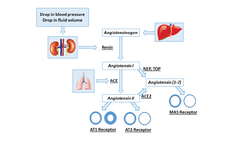Biology:Angiotensin (1-7)
| It has been suggested that talfirastide be merged into this page. (Discuss) Proposed since December 2023. |
| Angiotensin (1-7) | |
|---|---|
 | |
| Identifiers | |
| Symbol | Angiotensin (1-7) |
| SCOP2 | 2PJ8 / SCOPe / SUPFAM |
Angiotensin (1-7) (C41H62N12O11; Molecular weight = 899.02 g/mol; H-Asp-Arg-Val-Tyr-Ile-His-Pro-OH) is an active heptapeptide of the renin–angiotensin system (RAS).[citation needed]
In 1988, Santos et al demonstrated that angiotensin (1-7) was a main product of the incubation of angiotensin I with brain micropunch biopsies[1] and Schiavone et al reported the first biological effect of this heptapeptide.[2]
Angiotensin (1-7) is a vasodilator agent affecting cardiovascular organs, such as heart, blood vessels and kidneys, with functions frequently opposed to those attributed to the major effector component of the RAS, angiotensin II (Ang II).[3]
Synthesis
The polypeptide Ang I can be converted into Ang (1-7) by the actions of neprilysin (NEP)[4] and thimet oligopeptidase (TOP)[5] enzymes. Also, Ang II can be hydrolyzed into Ang (1-7) through the actions of angiotensin-converting enzyme 2 (ACE2). Ang (1-7) binds and activates the G-protein coupled receptor Mas receptor[6] leading to opposite effects of those of Ang II.

Possible pathways
- Action of neprilysin on angiotensin I or angiotensin II.
- Action of prolyl endopeptidase on angiotensin I.
- Action of ACE on angiotensin 1-9.
- Action of neprilysin on angiotensin 1-9.
- Action of ACE2 on angiotensin II.
Effects
Ang (1-7) has been shown to have anti-oxidant and anti-inflammatory effects.[7][8] It helps protect cardiomyocytes of spontaneously hypertensive rats by increasing the expression of endothelial and neuronal nitric oxide synthase enzymes, augmenting production of nitric oxide.[9]
Pharmacological interactions
Ang (1-7) contributes to the beneficial effects of ACE inhibitors and angiotensin II receptor type 1 antagonists.[10]
References
- ↑ "Converting enzyme activity and angiotensin metabolism in the dog brainstem". Hypertension 11 (2): 125–37. 1988. doi:10.1161/01.hyp.11.2_pt_2.i153. PMID 2831145.
- ↑ "Release of vasopressin from the rat hypothalamo-neurohypophysial system by angiotensin-(1-7) heptapeptide". PNAS 85 (11): 4095–8. 1988. doi:10.1073/pnas.85.11.4095. PMID 3375255. Bibcode: 1988PNAS...85.4095S.
- ↑ "The ACE2/Angiotensin-(1-7)/MAS Axis of the Renin-Angiotensin System: Focus on Angiotensin-(1-7)". Physiol Rev 1 (98): 505–553. 2018. doi:10.1152/physrev.00023.2016. PMID 29351514.
- ↑ "Biochemical evaluation of the renin-angiotensin system: the good, bad, and absolute?". American Journal of Physiology. Heart and Circulatory Physiology 310 (2): H137-52. January 2016. doi:10.1152/ajpheart.00618.2015. PMID 26475588.
- ↑ "Evidence for a mitochondrial angiotensin-(1-7) system in the kidney". American Journal of Physiology. Renal Physiology 310 (7): F637–F645. April 2016. doi:10.1152/ajprenal.00479.2015. PMID 26697984.
- ↑ "Angiotensin-(1-7) is an endogenous ligand for the G protein-coupled receptor Mas". Proceedings of the National Academy of Sciences of the United States of America 100 (14): 8258–63. July 2003. doi:10.1073/pnas.1432869100. PMID 12829792. Bibcode: 2003PNAS..100.8258S.
- ↑ "Angiotensin-(1-7) prevents activation of NADPH oxidase and renal vascular dysfunction in diabetic hypertensive rats". American Journal of Nephrology 28 (1): 25–33. 2008. doi:10.1159/000108758. PMID 17890855.
- ↑ "Angiotensin-(1-7) inhibits allergic inflammation, via the MAS1 receptor, through suppression of ERK1/2- and NF-κB-dependent pathways". British Journal of Pharmacology 166 (6): 1964–76. July 2012. doi:10.1111/j.1476-5381.2012.01905.x. PMID 22339213.
- ↑ "Angiotensin-(1-7) formation in the intact human heart: in vivo dependence on angiotensin II as substrate". Circulation 108 (14): 1679–81. October 2003. doi:10.1161/01.CIR.0000094733.61689.D4. PMID 14504185.
- ↑ "Angiotensin-(1-7) blockade attenuates captopril- or hydralazine-induced cardiovascular protection in spontaneously hypertensive rats treated with NG-nitro-L-arginine methyl ester". Journal of Cardiovascular Pharmacology 57 (5): 559–67. May 2011. doi:10.1097/FJC.0b013e31821324b6. PMID 21326110.
 |

